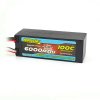So what battery would you buy new right now? Still hoping someone will give me a recommendation--including a good charger....
I am curious what battery to get, I used to use the "dumb" charger that came with my Q500 kit, but I started using my smart charger and I noticed that in one of my batteries one of the cells was way lower voltage than the other two, so I think that one is about at the end of its life. The chargers I have and love are from ISDT. Tiny little chargers but all the info and features I want, mainly individual cell health and the ability to put the battery in storage charge. I have the SC-608 and the Q8. You have to have a power supply for these smart chargers though, so I went to Value Village and found a laptop charger with the highest amperage rating and a common barrel plug, not a fancy plug, I got one of those and it didn't work, the one that works for me is a ASUS ADP-65JH BB, power output 19V at 3.4 Amps, perfectly within the chargers 9-32V input rating. Then it is an easy adapter to solder together, female barrel plug to male XT60, I got the barrel plug from my LHS, but you can get them way cheaper online be sure to quadruple check that the polarity is correct, a simple task with a voltmeter, and voila a Value Village power supply capable of charging at 3.4 AMPs, which I realize is less than 1c for a 5400mah Q500 battery, but the price is right, and for all my little drone batteries I can even charge more than 1c, though I do not recommend that, just for the longevity of your LIPOs, not necessarily for safety, many Lipos are rated for up to 5c fast charging, I just dont believe that you can do that and have them last.
sorry for the run on sentence, I'm just excited to have found this forum!
TL;DR Check out ISDT chargers
.




